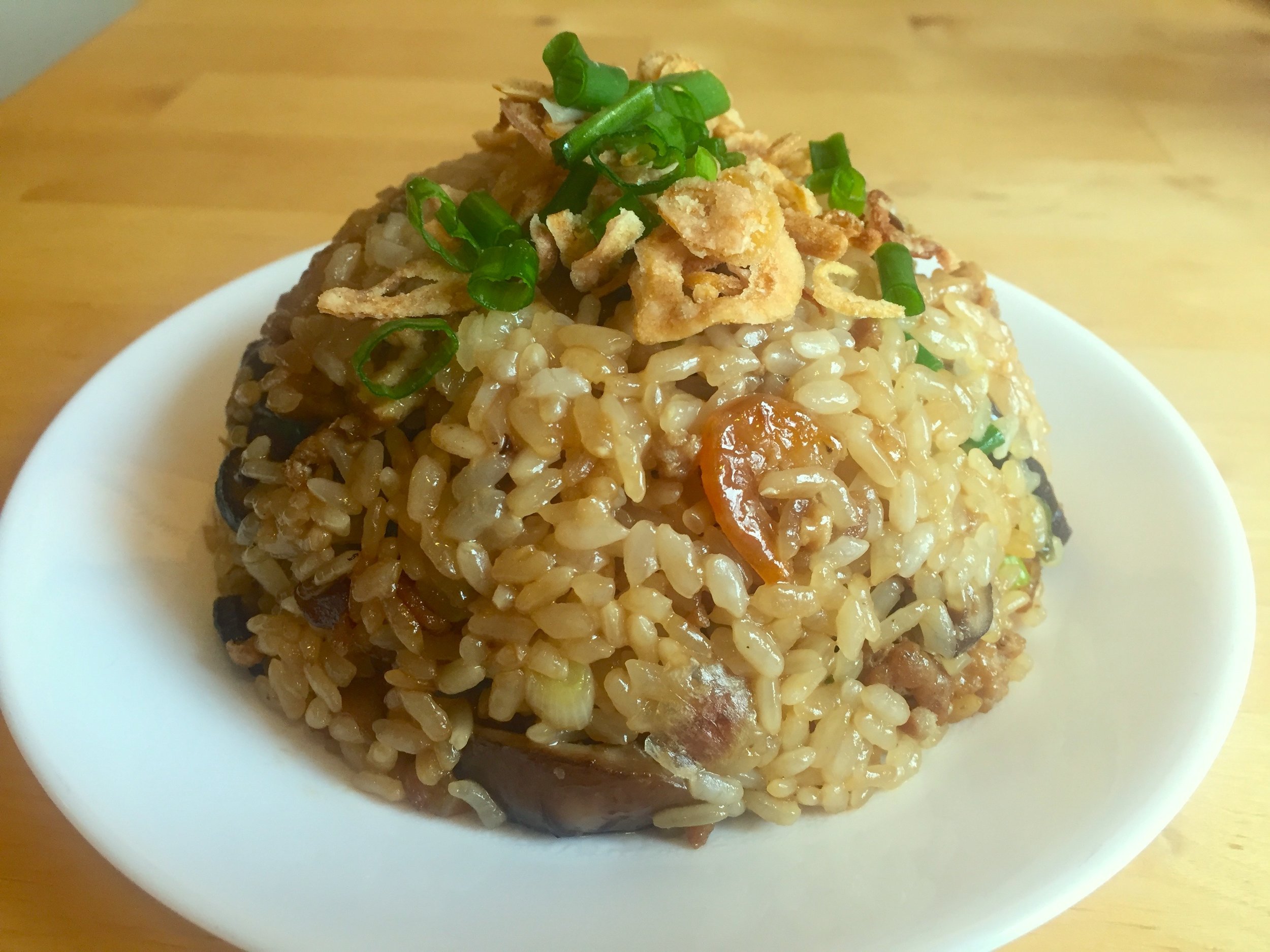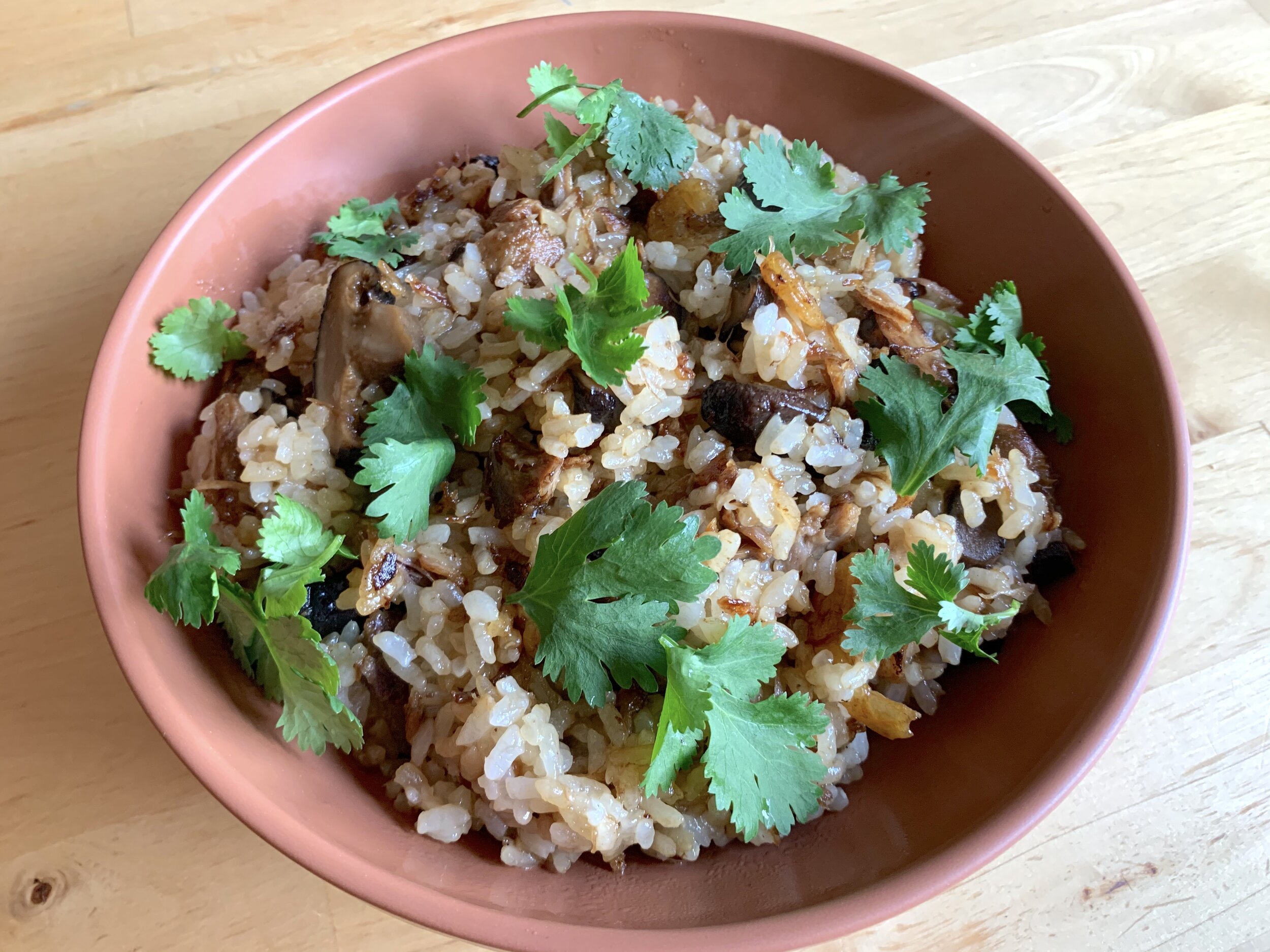Sticky Rice with Chinese Sausage

糯米饭 (Nuo Mi Fan)
Sticky rice is a common dish in East Asia, often cooked with various meats and flavored with soy sauce. There are many regional varieties of this dish, but the one presented here is the Cantonese variation commonly served at dim sum restaurants, a slightly sweet preparation which uses Chinese sausages. While many dim sum dishes are complicated to make at home, sticky rice is very straightforward to make—it is essentially a fried rice procedure, except with sticky rice instead of standard white rice. Cooked sticky rice also freezes well, making it a good option when cooking in bulk.
Ingredients
2 cups sticky rice
2 links Chinese sausage
4 oz (¼ batch) Taiwanese minced pork, cooked
5 shiitake mushrooms, sliced
¼ cup dried shrimp
2 tbsp soy sauce
1 tbsp dark soy sauce
1 tbsp brown sugar
2 scallions, chopped
Sticky rice, also known as sweet rice (though it does not taste sweet) and glutinous rice (though it is gluten free), is a common form of rice found on East and Southeast Asian tables. In Thailand and Laos in particular, where the rice has been grown for thousands of years, sticky rice is the staple form of rice consumed.
Sticky rice differs from other varieties of rice in that its starch consists almost entirely of amylopectin, with very little amylose.[1] Because amylopectin is more water soluble, sticky rice releases much more starch into its environment when cooked, thickening the water as a roux of cornstarch slurry would and creating a sticky, chewy texture. Most sticky rice found in supermarkets have been milled. However, you can sometimes find unmilled sticky rice with an intact coat of bran, which will appear purple or black (the sticky rice equivalent of standard brown rice). Sticky rice also exists in both long-grain and short-grain forms. For this recipe, we will be using two cups of milled, short-grain sticky rice.
A rice cooker is the easiest way to cook sticky rice—combine two cups of sticky rice with three cups of water and cook according to the manufacturer’s instructions. If your rice cooker has a dedicated sticky rice setting, use it! If your rice cooker doesn’t have a sticky rice setting, though, you are better off steaming the rice or cooking it on the stovetop. Soak the rice in cold water for about an hour before starting to cook it. After the soak, proceed as you would when cooking other type of rice. Be aware that sticky rice burns more readily than normal white rice. Also, be aware that because of the amount of starch released by sticky rice grains, draining excess water at any point in the cooking process is not an option. If you start with too much water, you will end up a gluey, unsalvageable mess. Regardless of your rice cooking method, it is better to err on the side of less water than more water, adding water gradually if the rice needs it.
While our rice is cooking, let us prepare our other ingredients. Soak the dried shrimp in cold water for 5-10 minutes before using them, to rinse off excess salt. Wash and dice the mushrooms. We will be using two links of Chinese sausage (香腸), a sweet pork sausage flavored with rice wine. Available at most Asian supermarkets, Chinese sausage has grown increasingly easy to find in recent years—even our local Costco now stocks it. Chinese sausage can be found in both fresh and dried varieties; either works in this recipe. Slice the sausage into rounds and add them to a cold skillet, cooking over low heat until the fat has rendered and the sausage is just crisp, about 5 minutes.
Then add the shrimp to the to the pan, turn the heat up to medium, and fry together for 1 minute. If there is insufficient rendered fat for frying, add a small amount of vegetable oil to the pan together with the shrimp. Follow the shrimp with the sliced mushrooms, and cook, stirring, for three more minutes, until the mushrooms are soft.
After the mushrooms, add the precooked Taiwanese minced pork, together with the chopped white parts of the scallions, and warm these ingredients through. At this point, this mixture is very stable. If the rice is still cooking, we can turn the heat off the pan and wait for the rice before we proceed to the next step.
When the rice is ready to be introduced, add the brown sugar to the pan over low heat and stir well. Follow this immediately with the rice. Our objective is to get the partially caramelized sugar predominately on the rice, rather than the other ingredients.
Break the rice up with a spatula, and add both soy sauces. The light soy sauce is providing most of the flavor here, with the dark soy sauce providing the color. Stir over low heat until the rice and other ingredients are well mixed, and the color of the rice is uniform, approximately 2-3 minutes.
The last step is to stir in the reserved green parts of our scallions. Then remove from heat and serve. Garnish with scallions, cilantro, fried shallots, or fried garlic.
If you want to emulate the standard presentation of sticky rice in Chinese restaurants, the inverted dome shape, simply find a bowl or mug of the appropriate shape and run it under hot water. Pour it out, leaving drops of water in the bowl. Pack the bowl tightly with the sticky rice, then place the service plate over the bowl. Invert them together, then gently lift the bowl off the plate. The hot water should help the bowl come away cleanly.
Substitutions
This dish is fairly flexible when it comes to the meat and vegetables involved. Char siu is sometimes used in lieu of or in addition to Chinese sausage.
If you want to make this dish vegetarian, omit the pork and dried shrimp, and double the amount of mushrooms in the dish, and add a diced white or yellow onion. Some variety in mushroom types will also help! You will likely have to add more salt or soy sauce, as the sausage, minced pork, and dried shrimp are all bringing salt to the dish.
[1] It has been determined that the abnormally high amylopectin content of sticky rice is the result of a single point mutation which was then selected for by early farmers. Olsen et al., Molecular Evidence on the Origin of Glutinous Rice, Genetics, 2002.
Recipe
Prep Time: 10 min Cook Time: 40 min Total Time: 50 min
Difficulty: 2/5
Heat Sources: 1 burner
Equipment: rice cooker (optional), pan
Servings: 6
Ingredients
2 cups sticky rice
2 links Chinese sausage
4 oz (¼ batch) Taiwanese minced pork, cooked
5 shiitake mushrooms, sliced
¼ cup dried shrimp
2 tbsp soy sauce
1 tbsp dark soy sauce
1 tbsp brown sugar
2 scallions, chopped
Instructions
1. In a rice cooker or in a pot on the stove, cook the sticky rice with three cups of water.
2. Chop the sausage into rounds and add them to a cold pan. Cook over low heat for 5 minutes, until the fat has rendered and the sausages are crisp.
3. Turn the heat up to medium, add the dried shrimp to the pan, and cook, stirring, for 1 minute.
4. Add the sliced mushrooms and cook for another 3 minutes.
5. Stir in the cooked minced pork and the white parts of the scallions, and stir until warmed through. Add the brown sugar to the pan and stir well.
6. Add the cooked sticky rice to the pan, breaking it up with a spatula. Follow immediately with both soy sauces. Turn the heat down to low and cook, stirring continuously, until the ingredients are well integrated and the sticky rice is uniform in color, about 2-3 minutes.
7. Mix in the remaining scallions, remove from heat, and serve. Garnish with scallion, cilantro, fried shallots, or fried garlic, as desired.

















